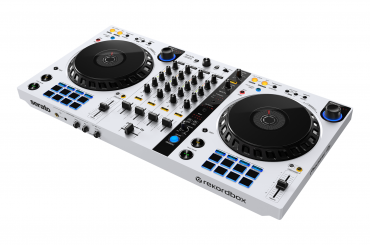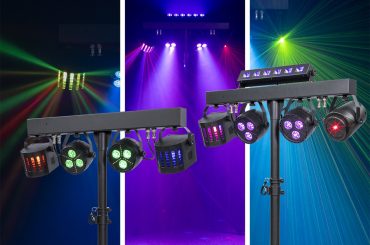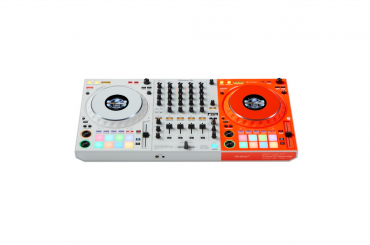By Mike Gwertzman
Roland’s Jupiter-8 and Juno-106 are easily two of electronic music’s most enduring and iconic analog synthesizers, workhorses whose distinctive sounds and features have cemented their place in the synth hall of fame.
The idea of having one modern, 8-voice polyphonic, USB-enabled synth that combines both of these classics into a single machine is an attractive concept. And that is really what lies at the heart of Roland’s stellar SYSTEM-8 PLUG-OUT Synthesizer, the most robust offering yet in the company’s celebrated AIRA product line. This is a 49-key synth, replete with an array of knobs and faders, using technology that allows you to swap in different synthesizer modules (and comes pre-loaded with both the Jupiter-8 and Juno-106), a smart fusion of analog functionality with digital flexibility.
The SYSTEM-8 continues with Roland’s recent practice of utilizing its rich legacy of classic synths to appeal to new and contemporary customers. This includes its boutique line of updated reproductions – such as the TB-03 and TR-09 (which are faithful recreations of the TB-303 and TR-909 respectively), and the System-1 Plug-Out, the slimmed-down, 25-key predecessor to the SYSTEM-8. The Roland PLUG-OUT synths are essentially digital platforms – along with the Jupiter and Juno modules, you can purchase and download SH-2, SH-101, System-100 and PROMARS plug-outs.
The SYSTEM-8 has three plug-out banks, and along with its SYSTEM-8 factory bank, you potentially have the ability to access four different banks of synth presets.
The SYSTEM-8 fits nicely with the AIRA design sensibility – soft black aluminum and plastic casing, with backlit neon green buttons, knobs, and fader banks surrounding the keyboard. The LED brightness on the green knobs can be adjusted, or even turned off. And for those who’d like to customize the look of their SYSTEM-8, Roland sells wood and brushed aluminum side panels.
Powering the sounds on the SYSTEM-8 is Roland’s Analog Circuit Behavior technology, the digital engine that is responsible for the rich analog reproductions on Roland’s recent products. And the sounds on the SYSTEM-8 are some of the best ACB ones yet.
There’s a wide range of styles with the three on-board sound banks, from contemporary leads and basses, to the classic pads, brasses and retro ’80s vibes that are so en vogue right now. I really was impressed with the quality of the presets and patches on the SYSTEM-8. After installing and setting it up, I found a nice selection of interesting new sounds that were balanced nicely by the throwback styles on the Jupiter and Juno banks. Lots of warmth, depth and character here – Roland’s ACB engine is top-notch, and you can really hear its range and power in full display with the SYSTEM-8.
The SYSTEM-8 gives you multiple options for sound design and shaping, as well as performance. Above the keyboard, on the left-hand side, are the LFO, two oscillators, and a third sub oscillator. The oscillators feature sawtooth, pulse and triangle waves, in both basic and “super” varieties. You can turn the color knob to beef up the sound, and there are also fine- and coarse-tuning options.
One of the best features of the SYSTEM-8 are the “variation” knobs that can modify the filter and the two main oscillators. For the oscillators, this means you have 12 different options at your fingertips – ranging from standard saw and sine waves, to FM, vowel and cowbell.
The filter on the SYSTEM-8 is another highlight. It brings out a tremendous range of tones, and again, gives you multiple options to shape sounds. The filter has three variations: a low-pass/high-pass (variation 1), a side-band filter (variation 2), and a low-pass filter based on Roland’s System-1 synth. You have four knobs to twist here (cutoff, resonance, envelope, and key) as well as a full four-band ADSR fader section.
The effects section offers up another wide ranging palette for audio manipulation. Here, you’ve got a distortion, delay/chorus and reverb to work with, and all three can be used at once. The delay/chorus is particularly useful, with time and level knobs to widen the sounds.
The SYSTEM-8 is particularly appealing to live performers, with two noteworthy features here. I really was impressed by the “performance” mode, which lets you play with two “panels” of sounds. That means your left hand (or the left hand of the keyboard) can play one patch, while the right section can play an entirely different patch. The SYSTEM-8 comes with 24 different patches of split presets to try – and it’s super-simple to change which panel plays which patch. (Performance mode can also layer both sound engines.) You can also set up performance mode so both panels are stacked on top of each other. And while in performance mode, you can choose which panel is selected – that means you can filter and modulate one patch, while the other plays normally.
The step sequencer is another live function that works very well. Located in the lower-right hand of the SYSTEM-8, the sequencer is a 16-step XoX-style sequencer, with a number of great options to choose from. I loved being able to record my sequence in real-time, and then go back in and edit, step by step. The “play mode” selector was also a lot of fun, with the “random” and “key trigger” options leading to some very creative possibilities.
It didn’t take much time working with the SYSTEM-8 to appreciate that this is a very well-designed and easy-to-use synth. The layout is very sensible, and all the features are easily accessible. I quickly became accustomed to navigating between the different options I wanted to use, and activating features like the arpeggiator and sequencer were very quick and easy. Switching between the patches was fast (no lag time), and there was no latency noticeable, even when switching between the different plug-outs. And it sounds absolutely stunning, evoking both classic analog goodness with modern tones.
It’s hard to find fault with the SYSTEM-8 to be honest. Analog enthusiasts might point out that the ACB technology is not “true analog,” so therefore the Jupiter and Juno emulations do not match up to the originals. And while this might be technically true, you’d be hard-pressed to find any noticeable difference. And aside from that debate, the flexibility gained from combining these two classics into one modern machine, with all the updated filters and oscillators, is a net win here.
Priced at $1,499, the SYSTEM-8 is Roland’s highest-priced AIRA option. It’s balancing itself between an expensive MIDI controller and a true analog synthesizer; Dave Smith Instruments Prophet-8, for example, is also priced at $1,499. I’d recommend getting your hands on the actual unit as well. Since it is encased in plastic, it’s absolutely fine for a studio setup, but might be a little bit of an issue for live performers. So it’s worth deciding what you’re looking for specifically in a synth before taking the plunge with the SYSTEM-8. I really liked the idea of the SYSTEM-8 being an updateable and expandable platform, provided, of course, that Roland keeps dropping new PLUG-OUT modules.
For producers, I see the SYSTEM-8 as a great synthesizer for someone who might be interested in transition between a software workflow and entering into more of a hardware setup. It’s easily compatible with your DAW via USB, but it also has plenty of options for connecting to other gear, with CV and gate outs in particular that would allow you to control a Eurorack. And the faders and knobs work great as control surfaces for softsynth MIDI parameters.
Overall, the SYSTEM-8 has something for everyone, but in this situation, everyone should be very happy with what they get. Will it be as iconic as the Jupiter-8 and the Juno-106? Time will tell. But it certainly works very well to deliver an updated, modern, and efficient evolution of these classics.








